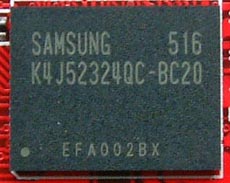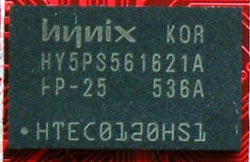The Boards
An overall description of the board configurations for the PowerColor X1300 PRO BRAVO Edition and X1300 128MB can be seen below:
Powercolor X1300 Board Details
| X1300 PRO BRAVO Edition | X1300 128MB (HyperMemory 2) | |
| Core Clock Rate | 600MHz | 400MHz |
| Pixel Pipelines | 4 | 4 |
| Pixel Fillrate | 2400Mpixels/sec | 1800Mpixels/sec |
| Texture Fillrate | 2400Mpixels/sec | 1800Mpixels/sec |
| Geometry Processors | 2 | 2 |
| Geometry Rate | 300Mtris/sec | 225Mtris/sec |
| Memory Speed | 400MHz | 400MHz |
| Memory Bandwidth | 12.8GB/s | 6.4GB/s |
| Frame Buffer Size | 256MiB | 128MiB |
| Host Interface | PCI Express x16 | PCI Express x16 |
On face value there is not a significant difference between the two boards, as they both use the same graphics processor. The PRO is clocked 33% higher than the bottom-end X1300 though so it's vertex and pixel throughput figures are affected accordingly. The most important distinction between the two models is the memory configuration, as the PRO sports 256MB of local memory on a 128-bit bus whereas the slower version offers 128MB on a 64-bit bus - combined with a difference in clock speeds, the PRO has approximately double the memory bandwidth.
Looking at the two board designs in comparison to ATI's reference layout, one can see that PowerColor changed little with their X1300 PRO BRAVO model other than using a heatsink of their own design. However, the BRAVO also utilises ATI's Rage Theater video encoding/decoding chip to complement the product's VIVO functionality (the additional PCB components that can be seen, such as capacitors, are most likely present for this reason). The X1300 128MB board is clearly aimed at a market populated by low-form and home media PCs as the PCB is a "3/5" design that appears only just big enough to house the RV515 chip.
The heatsink designs are quite simplistic being constructed of a basic coloured alloy; the surface area produced by the sink fins is not as substantial as something to be found on a top-end graphics card but with only 100 million transistors in the chip (and on a 90nm process), heat dissipation shouldn't be a struggle for the heatsinks to cope with. The PRO BRAVO board's unit looks as if it provides cooling for the memory chips but the metal plate does not make contact with them at all - if anything, the several mm of air between the chips and sink is likely to act as an insulator.


The above images show the memory modules used on the two PowerColor boards. The PRO uses four 512Mbit Samsung K4J52324QC-BC20 GDDR3 SDRAM chips - rated to 500MHz (2.0ns) but clocked at 396MHz, they are clearly operating well within their expected parameters. We shall investigate later in this review just how much of an impact the memory speed has on the Pro's performance but one could assume that PowerColor chose to run the chips 20% under their rating for heat and power purposes. In contrast, the lower X1300 board runs with four 256Mbit Hynix HY5PS561621AFP-25 GDDR2 SDRAM modules; these are rated to 400MHz (2.5ns) so are running on spec at 396MHz.
For a modern graphics card, even a budget one, a 64-bit 128MB memory configuration may seem somewhat old-fashioned but the X1300 board uses ATI's HyperMemory feature which permits the graphics card to treat the system memory as local memory, performing read/writes across the PCI Express interface - this provides up 8GB/sec of additional bandwidth and a total of 512MB addressable memory (on systems with 1GB or more of RAM; with 512MB systems a total graphics RAM size of 256MB is addressable). Although this is more than what the local memory actually provides, buffers such as colour and depth are still likely to be stored onboard whereas much larger buffers such as texture data would remain in the system RAM.
As mentioned above, the PRO BRAVO board comes with the Rage Theater video encoder/decoder chip, enabling video input capabilities, as well as TV-Output, but also differs from our other test sample in that it offers two DVI output sockets whereas the X1300 128MB sports just one DVI (but still permits dual displays via a D-SUB socket).




